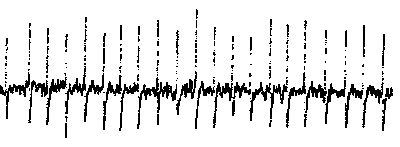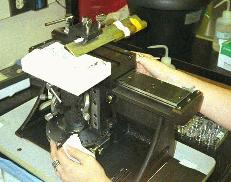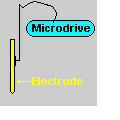 |
Sounds of Neuroscience |  |
 |
Sounds of Neuroscience |  |
The neuroscience laboratory is filled with different sounds - crackling from the amplified responses of neurons, scratching of a sliding microtome cutting tissue, the pumping of a respirator.
 Watch
Oscilloscope Watch
Oscilloscope |
Neuron in the thalamus: Oscilloscope tracing of the activity from neurons in the thalamus (nucleus parafascicularis). Click on the image to the left to start the movie. In the recording, you should be able to see several action potentials with different sizes. There is one large spike and several smaller ones. |
 Trigeminal Ganglion Cell: this is
about 2 seconds of activity that was recorded from a ganglion cell after
the maxillary (upper) incisor tooth of an anesthetized rat was tapped 5
times. Listen for 5 distinct "bursts" of action
potentials.
Trigeminal Ganglion Cell: this is
about 2 seconds of activity that was recorded from a ganglion cell after
the maxillary (upper) incisor tooth of an anesthetized rat was tapped 5
times. Listen for 5 distinct "bursts" of action
potentials.
 Trigeminal Ganglion Cell: this is
about 2 seconds of activity that was recorded from a rat ganglion cell
after a single whisker (vibrissa) was moved and held in position. Listen for the rapid steady burst of action potentials.
This neuron was firing about 100 action potentials every second. The
picture below is the actual recording of a portion of what you are
hearing...each action potential in
this record is separated by about 10 milliseconds. There are 21 action
potentials displayed in this picture of the recording - count them!
Trigeminal Ganglion Cell: this is
about 2 seconds of activity that was recorded from a rat ganglion cell
after a single whisker (vibrissa) was moved and held in position. Listen for the rapid steady burst of action potentials.
This neuron was firing about 100 action potentials every second. The
picture below is the actual recording of a portion of what you are
hearing...each action potential in
this record is separated by about 10 milliseconds. There are 21 action
potentials displayed in this picture of the recording - count them!

 Sliding Microtome: about 1 second of the
sound made by a sliding microtome as it cuts through a frozen brain. A
microtome is an instrument that is used to cut thin sections of tissue
that will be examined with a microscope. The brain is frozen with dry ice
and then cut into sections that are 50 microns thick. After the tissue
sections are cut, they are usually stained and mounted on glass
slides. Sliding Microtome: about 1 second of the
sound made by a sliding microtome as it cuts through a frozen brain. A
microtome is an instrument that is used to cut thin sections of tissue
that will be examined with a microscope. The brain is frozen with dry ice
and then cut into sections that are 50 microns thick. After the tissue
sections are cut, they are usually stained and mounted on glass
slides. |  The Microtome |
 Electronic Microdrive: a few
seconds of the sound of made by an electronic microdrive as it advances a
electrode into the brain. Every click that you hear is the electrode
advancing 1 micron (one thousandth of a millimeter). A microdrive is
used to position the electrode in a particular area of the brain for
recording activity from neurons. Electronic Microdrive: a few
seconds of the sound of made by an electronic microdrive as it advances a
electrode into the brain. Every click that you hear is the electrode
advancing 1 micron (one thousandth of a millimeter). A microdrive is
used to position the electrode in a particular area of the brain for
recording activity from neurons. |
 Electronic Microdrive |
| GO TO: | Explore the Nervous System | Table of Contents |
![[email]](./gif/menue.gif) Send |
 Get Newsletter |
 Search Pages |
 Donate to Neuroscience for Kids |